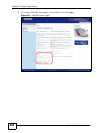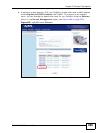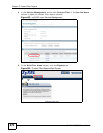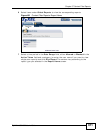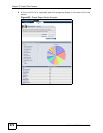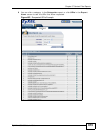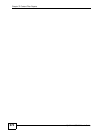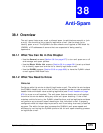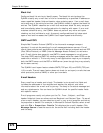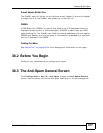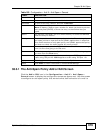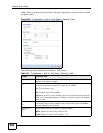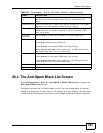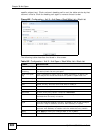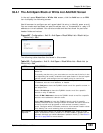
Chapter 38 Anti-Spam
ZyWALL USG 300 User’s Guide
676
Black List
Configure black list entries to identify spam. The black list entries have the
ZyWALL classify any e-mail that is from or forwarded by a specified IP address or
uses a specified header field and header value as being spam. If an e-mail does
not match any of the white list entries, the ZyWALL checks it against the black list
entries. The ZyWALL classifies an e-mail that matches a black list entry as spam
and immediately takes the configured action for dealing with spam. If an e-mail
matches a blacklist entry, the ZyWALL does not perform any more anti-spam
checking on that individual e-mail. A properly configured black list helps catch
spam e-mail and increases the ZyWALL’s anti-spam speed and efficiency.
SMTP and POP3
Simple Mail Transfer Protocol (SMTP) is the Internet’s message transport
standard. It controls the sending of e-mail messages between servers. E-mail
clients (also called e-mail applications) then use mail server protocols such as POP
(Post Office Protocol) or IMAP (Internet Message Access Protocol) to retrieve e-
mail. E-mail clients also generally use SMTP to send messages to a mail server.
The older POP2 requires SMTP for sending messages while the newer POP3 can be
used with or without it. This is why many e-mail applications require you to specify
both the SMTP server and the POP or IMAP server (even though they may actually
be the same server).
The ZyWALL’s anti-spam feature checks SMTP (TCP port 25) and POP3 (TCP port
110) e-mails. The anti-spam feature does not check (or act upon) e-mails that use
other protocols (such as IMAP) or other port numbers.
E-mail Headers
Every email has a header and a body. The header is structured into fields and
includes the addresses of the recipient and sender, the subject, and other
information about the e-mail and its journey. The body is the actual message text
and any attachments. You can have the ZyWALL check for specific header fields
with specific values.
E-mail programs usually only show you the To:, From:, Subject:, and Date:
header fields but there are others such as Received: and Content-Type:. To see all
of an e-mail’s header, you can select an e-mail in your e-mail program and look at
its properties or details. For example, in Microsoft’s Outlook Express, select a mail
and click File > Properties > Details. This displays the e-mail’s header. Click
Message Source to see the source for the entire mail including both the header
and the body.



